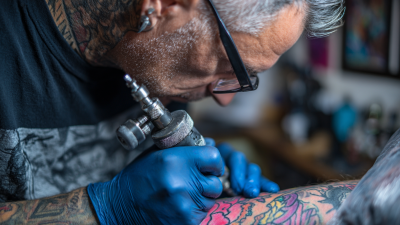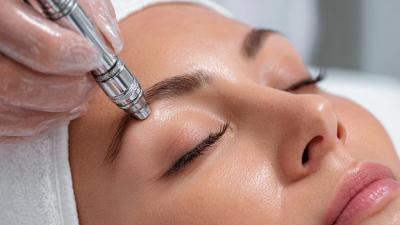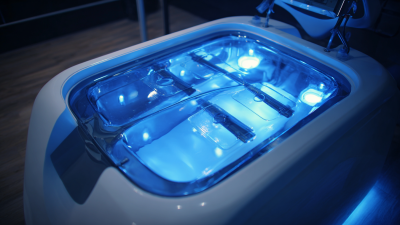Unlocking the Secrets of Modern Laser Removal Machines: Your Guide to Safe and Effective Treatments
In the realm of cosmetic and medical dermatology, the advent of advanced technology has revolutionized the way we approach various skin concerns. Among these innovations, the Laser Removal Machine stands out as a groundbreaking solution for effectively treating unwanted tattoos, pigmentation, and skin imperfections. Understanding how these machines operate, combined with a comprehensive knowledge of their benefits and safety measures, empowers individuals to make informed decisions about their treatment options.

This guide aims to demystify the intricacies of modern Laser Removal Machines, exploring their types, functionalities, and the science behind their effectiveness. From Q-switched lasers to fractional lasers, each type offers unique advantages tailored to specific skin types and conditions. As we delve into the various kinds of laser removal technologies, we will highlight key factors for ensuring safe and effective treatments, mitigating potential risks, and optimizing results.
In an era where aesthetic preferences evolve and enhancing one’s appearance has become a priority for many, knowing what to expect from a Laser Removal Machine is crucial. By unlocking the secrets of these advanced devices, individuals can embrace their journey towards clearer, healthier skin with confidence.
Understanding the Science Behind Laser Removal Technologies
The science behind modern laser removal technologies is fascinating and intricate, driving significant advancements in safety and efficacy for various treatments. Laser removal devices operate through selective photothermolysis, a process where specific wavelengths of light target and destroy unwanted tissues while sparing surrounding skin. According to a report from the American Society for Dermatologic Surgery, laser treatments have grown by over 50% in the past five years, indicating their increasing popularity in cosmetic procedures.
When considering laser removal treatments, it is essential to understand the different types of lasers available. For example, the Nd:YAG laser is highly effective for deeper pigment removal, while the Alexandrite laser is often used for hair removal due to its efficiency on lighter skin types. Recent studies published in the Journal of Cosmetic Dermatology show that patients report satisfaction rates exceeding 85% following laser treatments, particularly when executed by certified professionals.
Tips: Always consult with a qualified dermatologist before undergoing laser treatments to ensure the appropriate technology is utilized for your specific needs. It’s also wise to inquire about the practitioner’s experience and the type of laser equipment used to ensure optimal safety and efficacy. Lastly, follow post-treatment care instructions diligently to enhance healing and achieve the best results.
Key Types of Laser Removal Machines and Their Applications
Laser removal machines have revolutionized various aesthetic and medical treatments, offering effective solutions for tattoo removal, skin resurfacing, and hair removal. The two primary types of laser machines used for these applications are Q-switched lasers and fractional lasers. According to the American Society for Dermatologic Surgery, Q-switched lasers are particularly effective for tattoo removal, allowing for the breakdown of ink particles without causing significant damage to the surrounding skin.
Fractional lasers, on the other hand, excel in skin rejuvenation and resurfacing treatments. A report by Grand View Research highlights that the fractional laser market is projected to reach USD 6.1 billion by 2025 due to increasing demand for minimally invasive cosmetic procedures. These lasers treat a fraction of the skin at a time, promoting faster healing and less downtime for patients. Both types of lasers can be fine-tuned based on the treatment area and desired results, ensuring a personalized approach to each patient’s needs.
Unlocking the Secrets of Modern Laser Removal Machines: Your Guide to Safe and Effective Treatments
| Laser Type | Wavelength (nm) | Common Uses | Skin Types | Safety Level |
|---|---|---|---|---|
| Alexandrite Laser | 755 | Hair Removal, Pigment Lesions | I to III | High |
| Nd:YAG Laser | 1064 | Tattoo Removal, Vascular Lesions | I to VI | Moderate |
| Diode Laser | 800-810 | Hair Removal, Acne Treatment | I to IV | High |
| CO2 Laser | 10600 | Skin Resurfacing, Scar Treatment | I to IV | Low |
| Erbium YAG Laser | 2940 | Skin Resurfacing, Wrinkle Reduction | I to IV | Moderate |
Safety Protocols and Best Practices for Laser Treatments
When considering laser removal treatments, safety should be the primary concern for both patients and practitioners. Before undergoing any procedures, ensure that the clinic follows stringent safety protocols, including proper sterilization of equipment and use of protective eyewear for both the patient and technician. Practitioners should also be adequately trained and certified in laser technology to minimize risks associated with the procedure.
**Tips:** Always verify the qualifications of your practitioner and check for reviews or testimonials from past patients. A reputable clinic should offer a thorough consultation to address any concerns regarding the treatment.
Moreover, aftercare is crucial for safe recovery. Patients should be advised on how to care for their skin post-treatment, which may include avoiding sun exposure and using gentle cleansers. Keeping the area hydrated is essential as well.
**Tips:** Utilize high-quality sunscreen and follow your practitioner’s aftercare instructions meticulously to ensure the best results while minimizing complications. Taking these precautions will not only enhance the effectiveness of the treatment but also promote safer laser removal experiences.
Clinical Efficacy: Success Rates and Patient Outcomes
The clinical efficacy of modern laser removal machines is evident in their impressive success rates and positive patient outcomes. These advanced devices utilize targeted wavelengths of light to selectively destroy unwanted pigments or hair follicles while minimizing damage to the surrounding tissues. Clinical studies have consistently shown that patients experience significant reductions in hair growth and pigment imperfections after a series of treatments. The precision of laser technology allows practitioners to tailor therapies to individual skin types and conditions, further enhancing efficacy.
Moreover, patient outcomes following laser treatments often reflect high satisfaction rates. Many individuals report visible improvements soon after their initial sessions, which can lead to increased confidence and quality of life. The relatively quick recovery time associated with these procedures compared to older methods makes them appealing options for those seeking effective solutions with minimal downtime. Ongoing advancements in laser technology continue to refine these treatments, promising even better results and safety for a diverse range of patients.
Recent Innovations and Future Trends in Laser Removal Procedures
Recent advancements in laser removal technology have significantly enhanced the effectiveness and safety of various treatments. According to a report by Market Research Future, the global laser hair removal market is projected to grow at a CAGR of 18.9% from 2020 to 2027, driven by increasing demand for non-invasive aesthetic procedures. Innovations such as picosecond lasers and fractional laser technologies have emerged, providing quicker treatment times and reduced side effects. These advancements not only improve results but also cater to a broader range of skin types and concerns, making laser treatments more accessible.
When considering laser removal procedures, it's important to prioritize safety. Always choose an experienced provider with a proven track record. Look for clinics that utilize FDA-approved devices, as safety standards can vary widely. Moreover, pre-treatment consultations are crucial; they allow practitioners to assess individual skin types and recommend the most suitable laser technology.
Tip: Always inquire about the technology used in your desired treatment to ensure it aligns with your skin needs. Additionally, consider the clinic's follow-up care procedures, as they can significantly affect the overall outcome. A well-informed choice leads to better results and a more satisfying treatment experience.
Related Posts
-

How to Effectively Choose the Right Laser Removal Machine for Your Needs
-

Ultimate Checklist for Choosing the Best Tattoo Removal Machine in 2023
-

10 Essential Tips for Choosing the Perfect Microdermabrasion Machine for Your Salon
-

7 Essential Tips to Elevate Your Laser Beauty Equipment Business
-

Understanding the Fundamentals of Laser Tattoo Removal Machines: A Comprehensive Guide
-

Exploring the Science Behind Cavitation Machines: Revolutionizing Fat Reduction Technology
